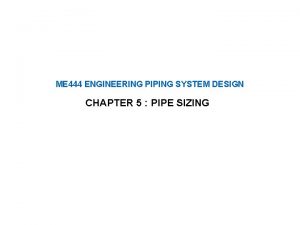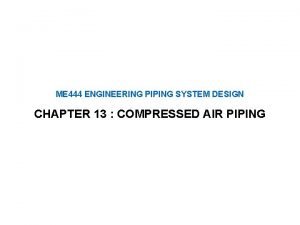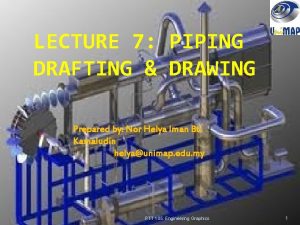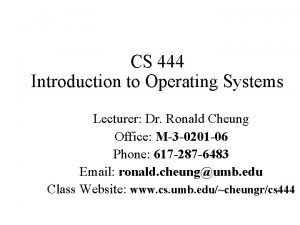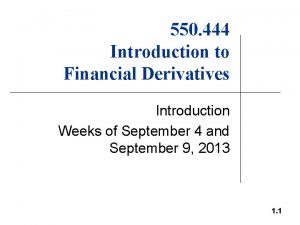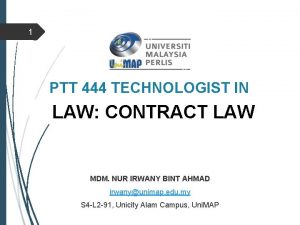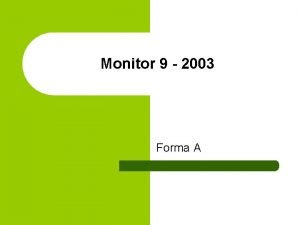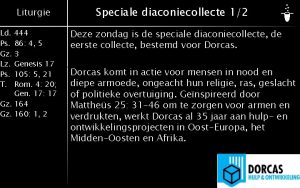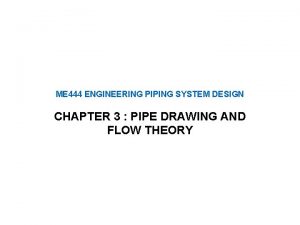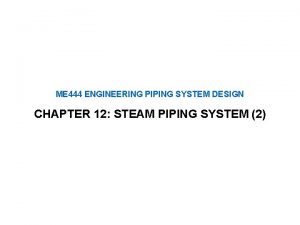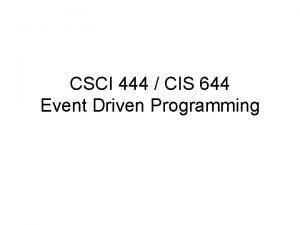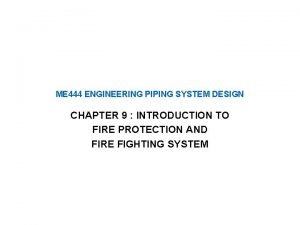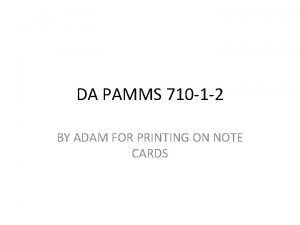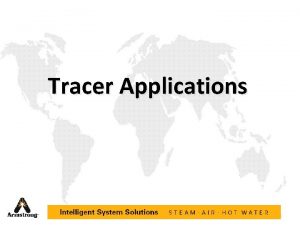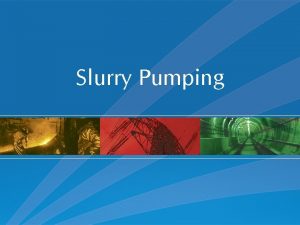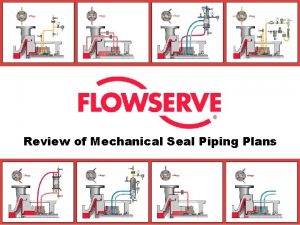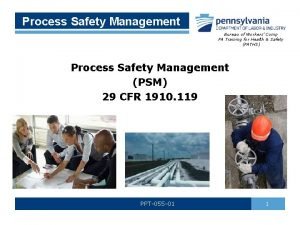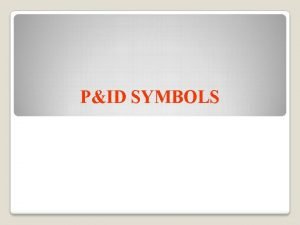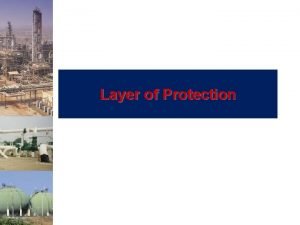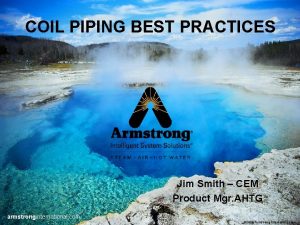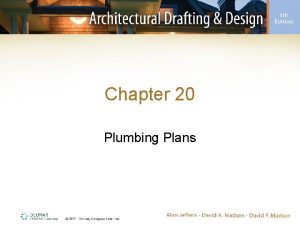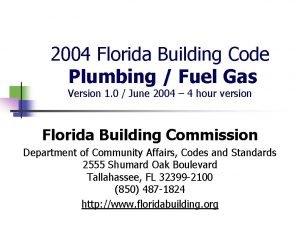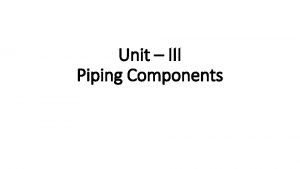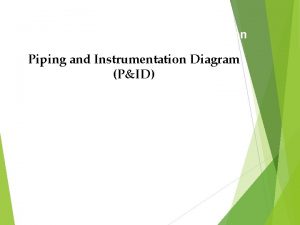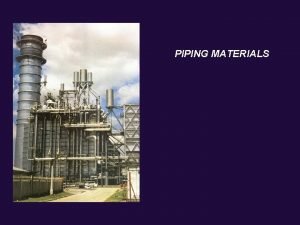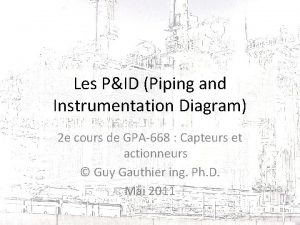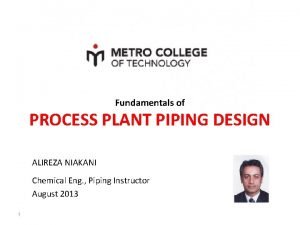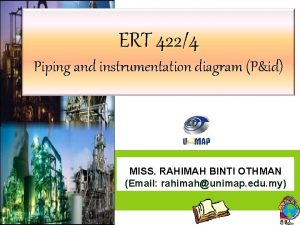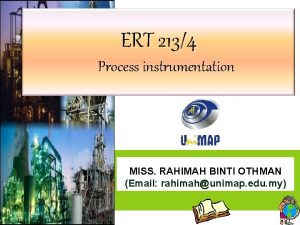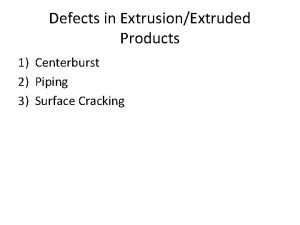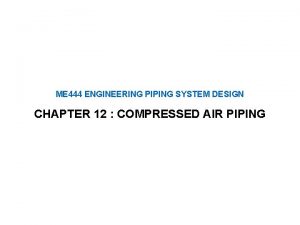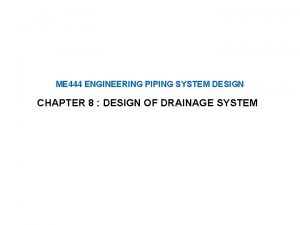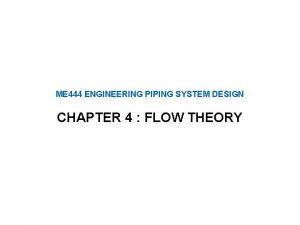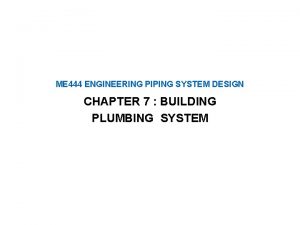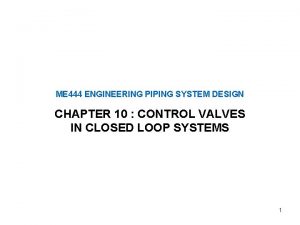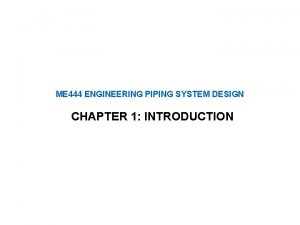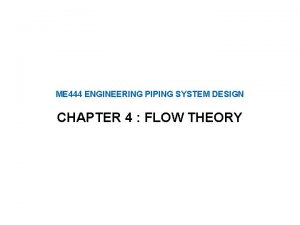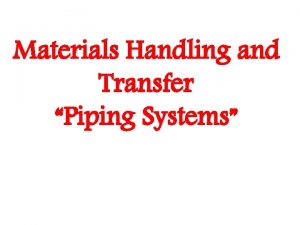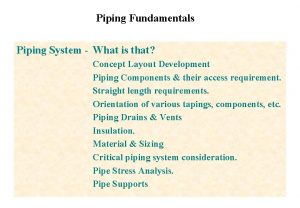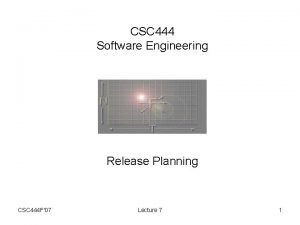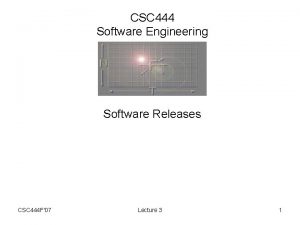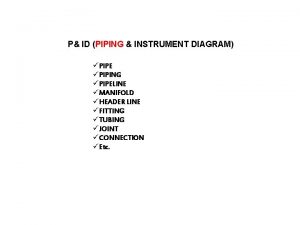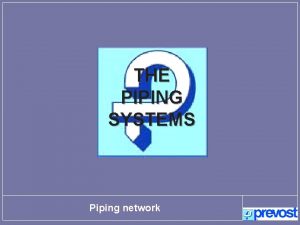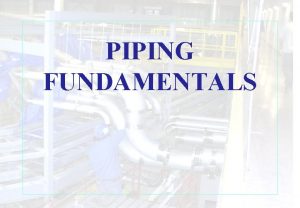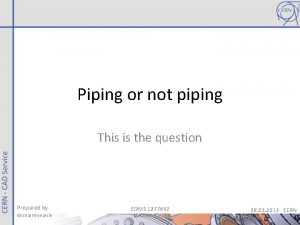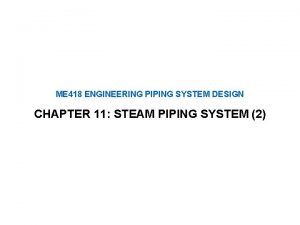ME 444 ENGINEERING PIPING SYSTEM DESIGN CHAPTER 5














































- Slides: 46

ME 444 ENGINEERING PIPING SYSTEM DESIGN CHAPTER 5 : PIPE SIZING

LAST SESSION 1. 2. 3. 4. CHARACTERISTICS OF FLOW BASIC EQUATIONS PRESSURE DROP IN PIPE ENERGY BLANCE IN FLUID FLOW

CONTENTS 1. PIPING SYSTEM DESIGN PROCEDURE 2. PIPE THICKNESS 3. PIPE SIZING AND SYSTEM PRESSURE DROP

1. PIPING SYSTEM DESIGN PROCEDURE Always works from the output then determine the input and the piping system SOURCE PIPING SYSTEM END USERS

DESIGN PROCEDURE 1. Study system specification, type and properties of fluid. 2. Determine material specification, pressure rating, temperature rating of equipment. 3. Gather end user requirements: location, pressure, temperature, flow rate. 4. Consider the availability of the source. Is there enough pressure and flow rate?

DESIGN PROCEDURE (2) 5. Study architectural drawings. Design the path of the pipeline. Determine the use of valves and other accessories. 6. Perform detail design: pipe sizing. 7. Pump selection (if required) 8. For power piping system, evaluate strength of pipes.

DESIGN PROCEDURE (3) 9. Create drawings of the plan, schematic and detail installation. 10. Adjust the drawing to combine with other systems. 11. Evaluate construction cost.

2. PIPE THICKNESS s 2 p s 1 Hoop stress s 1 or sq Internal pressure Internal diameter Barlow equation Pipe wall thickness

ASME B 31 Adjust the Barlow equation to account for other factors. Material Strength Joint efficiency factor Tolerance Temperature factor

Material Strength

Joint Efficiency Factor

Temperature Factor

Tolerance

3. PIPE SIZING

Recommended Velocity Type of pipe Velocity (m/s) Pump discharge 2. 4 – 3. 6 Pump suction 1. 2 – 2. 1 Drain pipe 1. 2 – 2. 1 Header 1. 2 – 4. 6 Riser 0. 9 – 3. 0 General water supply 1. 2 – 3. 0 Main potable water supply 0. 9 – 2. 1 Boiler feed water 2. 5 – 4. 6

Maximum Velocity to Prevent Erosion Service hours per year Max. Velocity (m/s) 1500 3. 66 2000 3. 51 3000 3. 35 4000 3. 05 6000 2. 74 8000 2. 44

Maximum Velocity to Prevent Erosion

Recommend velocity for different pipe sizes Small pipe higher drop at same velocity

Case 1: Size by velocity 1. Determine flow rate in each section 2. Sizing pipe according to velocity 3. Compute pressure drop Flowrate (lpm) DN (mm) Velocity (m/s) Pressure Drop (m/100 m) 9 (14)* 15 0. 8 (1. 2) 6. 24 (14. 2) 20 (24)* 20 1. 0 (1. 2) 6. 72 (9. 45) 39 25 1. 2 6. 98 78 32 1. 4 6. 98 120 40 1. 5 6. 73 230 50 1. 8 6. 57 390 65 2. 1 6. 88 670 80 2. 3 6. 88 1, 200 100 2. 4 5. 31 1, 850 125 2. 4 3. 88

Size by velocity

Example 5. 1 A pipeline from A to B is used to fill the tank so that the water level is maintained between 1 m 3 and 4 m 3. The water is used at the rate of 500 lpm for 10 minutes in every hour. Apply 25% loss in fitting Determine the pipe size and the required pressure at A

Example 5. 1 (2) Water consumption period § 500 lpm for 10 minutes = 5 m 3 § There are 3 m 3 storage § Need to add 2 m 3 in 10 minutes § Equivalent of 200 lpm

Example 5. 1 (3) None consumption period § Fill 3 m 3 storage in 50 minutes § Equivalent of 60 lpm § Design pipe A-B at 200 lpm § From table 5. 5 select DN 50

Example 5. 1 (4) 5. 04 m/100 m 200 lpm

Example 5. 1 (4) § Total length = 91 m § Equivalent length = 91 + 25% = 114 m § Pressure drop = 114 x 5. 04/100 = 5. 75 m. WG. §Pressure required at B = 0. 5 bar §Pressure required at A = Elevation+Pressure drop+End pressure 40 + 5. 75 + 5. 1 = 50. 85 m. WG.

Case 2: Size by pressure drop 1. Measure the critical path 2. Add 25%-50% for minor loss 3. Compute allowable pressure drop per 100 m 4. Extract data from the graph to form a reference table 5. Determine flow rate in each section 6. Size each section according to the table 7. Compute actual pressure drop

Table 5. 4

Example 5. 2 Design a main pipe to supply water from 30 m. storage tank to a factory loacated 200 m away. The water pressure at the meter in front of the factory shall be more than 2 bar(g) when the factory consumes 2000 lpm. Assume 25% minor loss.

Example 5. 2 (2) 30 meter elevation = 30 m. WG. Pressure drop Dp 2 bar(g) = 20. 4 m. WG. = 30 -20. 4 = 9. 6 m. WG. Equivalent pipe length 200 m + 25% minor loss = 250 m Pressure drop rate = 9. 6 m. WG. / 250 m * 100 m = 3. 84 m/100 m

Example 5. 2 (2) 2000 lpm @ <3. 84 m/100 m DN 150

Example 5. 3 A 2 storey factory require water supply of 20 lpm at 1. 5 barg to each of its 30 outlets. The horizontal pipe shall run at 1 m. below the ceiling of each floor, then drop down to the outlet 1 m. above the floor. Use factor of each branch = 100% Use factor of each floor = 80% Overall use factor = 80% Size the pipe Underground pump can supply 480 lpm@32 m. WG.

Example 5. 3 (2) Pressure added by pump Critical path = A I 480 lpm@32 m. WG.

Example 5. 3 (3) 1. Measure length of the critical path = A I 2. Compute equivalent length 480 lpm@32 m. WG.

Example 5. 3 (4) 3. Compute pressure drop per 100 m m/100 m 480 lpm@32 m. WG.

Max Flowrate (lpm) Pipe Size DN (mm) Velocity (m/s) 15 0. 6 3. 94 15 20 0. 7 3. 95 29 25 0. 9 4. 00 58 32 1. 0 3. 99 91 40 1. 2 3. 99 177 50 1. 4 3. 99 293 65 1. 5 3. 98 500 80 1. 7 3. 92 Example 5. 3 (5)7 Pressure drop (m/100 m) 4. Construct pipe sizing table Flowrate (lpm) Pressure drop (m/100 m)

Example 5. 3 (6) 5. Sum up the flow in each section Sum Flow rate Use factor (lpm) Design Flow rate Length )lpm( (m ) A-B 600 80% 480 6 B-C 300 80% 240 84 C-D 200 100% 200 20 D-E 100% 100 30 E-F 80 100% 80 10 F-G 60 100% 60 10 G-H 40 100% 40 10 H-I 20 100% 20 12

Example 5. 3 (7) 6 Size the pipe and 7 compute pressure drop Max Flowrate (lpm) Pipe Size DN (mm) Velocity (m/s) 7 15 15 Pressure drop Section Length (m/100 m) Design Flow rate Pipe Size Velocity DN Pressure Drop 0. 6 3. 94 )lpm( (m ) (mm) (m/s) 20 0. 7 3. 95 m/ 100 m 29 25 0. 9 4. 00 A-B 480 6 80 1. 677 3. 63 0. 22 58 32 1. 0 3. 99 B-C 240 84 65 1. 263 2. 73 2. 29 91 40 1. 2 3. 99 C-D 200 20 65 1. 052 1. 94 0. 39 177 50 1. 4 3. 99 D-E 100 30 50 0. 770 1. 37 0. 41 293 65 1. 5 3. 98 E-F 80 10 40 1. 015 3. 13 0. 31 500 80 1. 7 3. 92 F-G 60 10 40 0. 761 1. 83 0. 18 G-H 40 10 32 0. 711 2. 00 0. 20 H-I 20 12 25 0. 598 2. 02 0. 24 รวม 4. 25 m

Example 5. 3 (8) 7. Fine tuning the design. Section Design Flow rate Length Pipe Size Velocity DN Pressure drop )lpm( (m) (mm) A-B 480 6 80 m/ 100 m 1. 677 3. 63 B-C 240 84 65 1. 263 2. 73 2. 29 C-D 200 20 65 1. 052 1. 94 0. 39 D-E 100 30 40 1. 268 4. 77 1. 43 E-F 80 10 40 1. 015 3. 13 0. 31 F-G 60 10 40 0. 761 1. 83 0. 18 G-H 40 10 40 0. 507 0. 87 0. 09 H-I 20 12 25 0. 598 2. 02 0. 24 รวม 5. 15 (m/s) m 0. 22

Example 5. 3 (9) 8. Draw the pipe sizes

Comments § Actual pressure drop usually smaller than the design limit. § If there the outlets are just exits, the flow will be very high at the outlets located near the pump and very low at the last one. § The actual operating point of the pump may vary (discussed in the next chapter) § In actual condition there will be valves at the outlets to control the flow.

Example 5. 4 Size the condenser water pipes for 100 Ton. R system and compute the required pump head. The required circulation rate is 9 lpm/Ton. R. 1 barg is required at B

Example 5. 4 (2) Required flowrate = 9 lpm/ton. R x 100 ton. R = 900 lpm Supply Return 6 + 40 + 10 + 2. 5 = 58. 5 m 6 + 40 + 1 = 57 m Supply+Return = 115. 5 m Equivalent Length = 115. 5 x 1. 25 = 144 m

Example 5. 4 (3) Size the pipe for 4 m/100 m pressure drop At 900 lpm อตราไหล สงสด (lpm) ขนาดระบ DN (mm) ความเรว (m/s) ความดนตก (m/100 m) 7 (14)* 15 0. 6 (1. 2) 3. 94 (14. 2) 15 (24)* 20 0. 7 (1. 2) 3. 95 (9. 45) 29 (40)* 25 0. 9 (1. 2) 4. 00 (7. 32) 58 (66)* 32 1. 0 (1. 2) 3. 99 (5. 09) 91 40 1. 2 3. 99 177 50 1. 4 3. 99 293 65 1. 5 3. 98 500 80 1. 7 3. 92 1, 000 100 2. 0 3. 74 1, 850 125 2. 4 3. 88 2, 700 150 2. 4 3. 17

Example 5. 4 (4) At 900 lpm actual pressure drop = 3. 06 m/100 m So drop in pipe = 3. 06/100 x 143 = 4. 41 m. WG. Pressure require at pump = Pressure drop in pipe + Pressure drop in chiller+ Pressure required at B + Elevation = 4. 41 + 7 + 1. 5 + 10. 2 = 23. 1 m. WG.

Comments § Elevation is the different between suction and discharge of the pump § During installation both pipe must be filled before pump can operate § What is the difference btw installing pump on roof and in the basement? § In practical the condenser pipe shall be the next larger size to account for scale forming in a long run

Homework
 Me 444
Me 444 Me 444
Me 444 Piping engineering drawing
Piping engineering drawing 444 5 lecke
444 5 lecke Artinya 444 555 666 888 33 88
Artinya 444 555 666 888 33 88 Cs 444 oregon state
Cs 444 oregon state Cs 444
Cs 444 Ptt 444
Ptt 444 550-444
550-444 Unliquidated damages definition
Unliquidated damages definition Ciferny sucet cisla 444
Ciferny sucet cisla 444 Lied 444
Lied 444 444
444 Jamil bin harun v yang kamsiah
Jamil bin harun v yang kamsiah Https://bit.ly/3fvyjws
Https://bit.ly/3fvyjws -vertical
-vertical Me 444
Me 444 N 444
N 444 444 outline
444 outline Kto uzem
Kto uzem 444 ptt
444 ptt Sprinkler pipe size chart
Sprinkler pipe size chart Artaxerxes decree 444
Artaxerxes decree 444 Artaxerxes decree 445
Artaxerxes decree 445 Da form 444
Da form 444 444 римскими цифрами
444 римскими цифрами /mapi/emsmdb/ mailboxid
/mapi/emsmdb/ mailboxid System procurement process in software engineering
System procurement process in software engineering Steam tracer
Steam tracer Slurry pump suction piping
Slurry pump suction piping Pump seal plans
Pump seal plans Health concerns
Health concerns P id symbols
P id symbols Layers of protection
Layers of protection Creo piping
Creo piping Cadactive
Cadactive Steam coil piping detail
Steam coil piping detail Plumbing and piping plan
Plumbing and piping plan Florida building code gas piping
Florida building code gas piping Pipe component
Pipe component Process instrumentation diagram
Process instrumentation diagram Piping
Piping Pid instrument
Pid instrument Process plant piping
Process plant piping P&id lt
P&id lt Piping and instrumentation diagram (p&id)
Piping and instrumentation diagram (p&id) Pipe defect in extrusion
Pipe defect in extrusion
